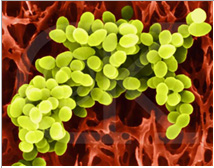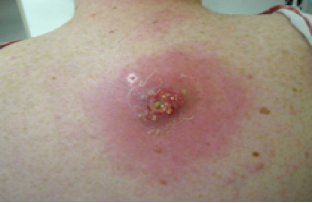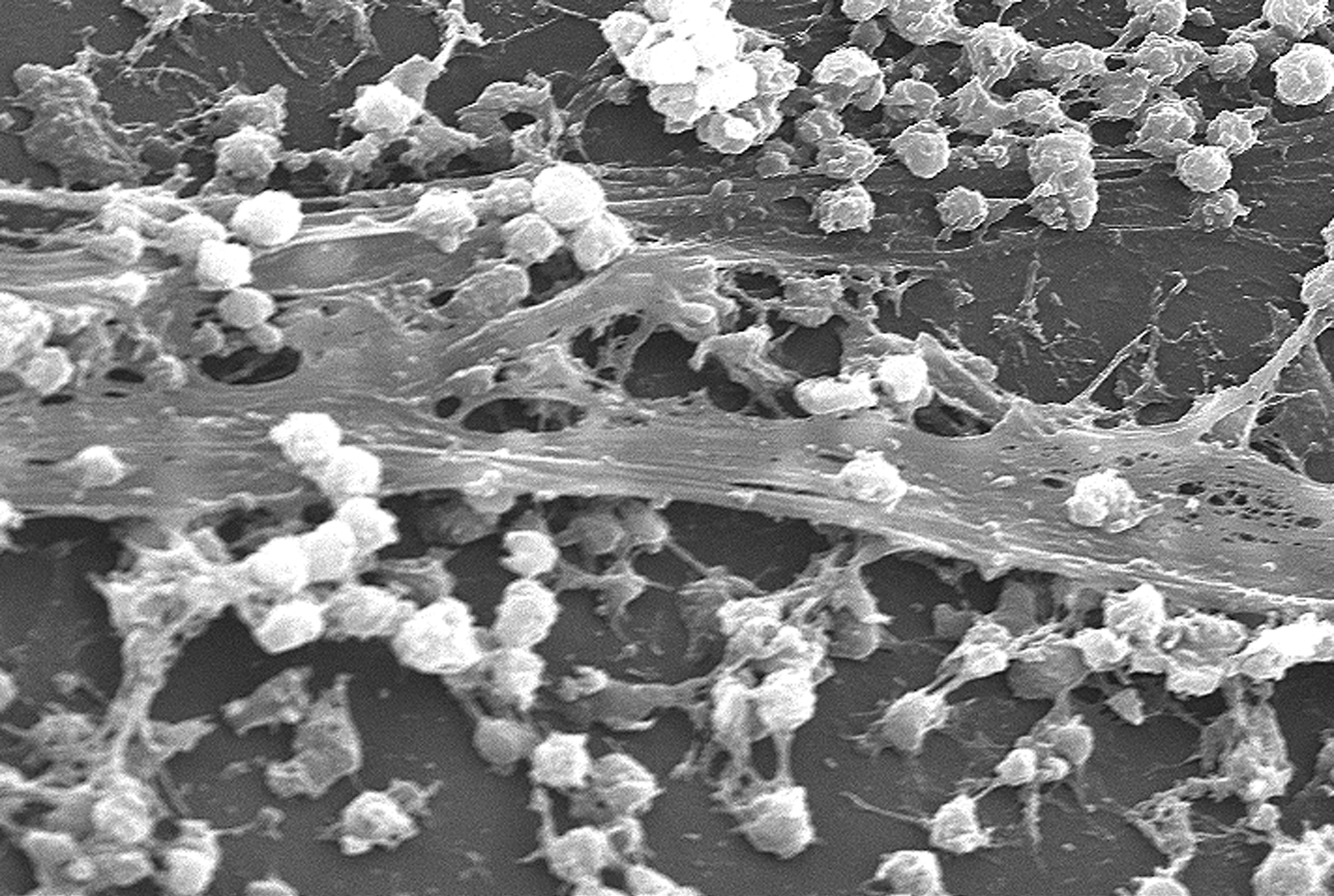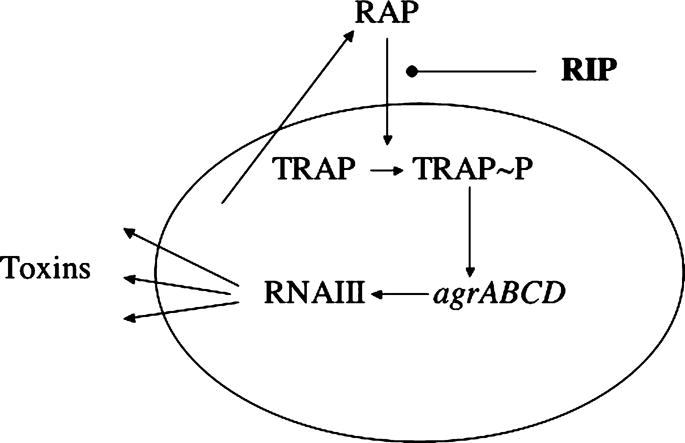Team:SDU-Denmark/Background
From 2009.igem.org
(→Biofilm Formation) |
(→Biofilm Formation) |
||
| Line 61: | Line 61: | ||
S. aureus biofilm formation dependents on two quorum-sensing systems, leading to expression of RNAIII that regulates expression of genes involved in pathogenesis. Other staphylococcus strains have developed a RNAIII-inhibiting peptide (RIP) that quenches quorum-sensing, and reduces RNAIII transcription and biofilm formation in S. aureus. | S. aureus biofilm formation dependents on two quorum-sensing systems, leading to expression of RNAIII that regulates expression of genes involved in pathogenesis. Other staphylococcus strains have developed a RNAIII-inhibiting peptide (RIP) that quenches quorum-sensing, and reduces RNAIII transcription and biofilm formation in S. aureus. | ||
| - | [[Image:SDU-Denmark-Slimy_business.jpg| | + | [[Image:SDU-Denmark-Slimy_business.jpg|360px|thumb|left|Figure 4. The five stages of bacterial biofilm formation. (A) Bacteria reversibly attach to solid support. (B) Bacteria become irreversibly attached, and aggregate to form matrix. (C) Maturation phase: cells become layered and effects of quorum sensing begin. (D) Clusters reach maximum thickness. (E) Escape of planktonic bacteria from matrix dispersion;.From Slimy business—the biotechnology of biofilms; Nature 21, 361 - 365 (2003) ]] |
[[Image:SDU-Denmark-Staphylococcus_aureus_biofilm_01.jpg|200px|thumb|right|Figure 5. S.aureus biofilm [http://en.wikipedia.org/wiki/File:Staphylococcus_aureus_biofilm_01.jpg (11)] ]] | [[Image:SDU-Denmark-Staphylococcus_aureus_biofilm_01.jpg|200px|thumb|right|Figure 5. S.aureus biofilm [http://en.wikipedia.org/wiki/File:Staphylococcus_aureus_biofilm_01.jpg (11)] ]] | ||
Revision as of 12:50, 21 October 2009

Description of S. aureus
Staphylococcus aureus, also known as golden staph, is the most common cause of staphylococcus infections. It is a gram positive bacterium, that normally can be treated with penicillin. Unfortunately they are becoming more and more resistant to common antibiotics and thereby harder to treat ([http://www.denstoredanske.dk/Krop,_psyke_og_sundhed/Sundhedsvidenskab/Farmakologi/penicillin 1]).
The nose is regarded as the major site of S. aureus carriage from where the organisms can spread to other parts of the body. About 20% of the population are long-term carriers of S. aureus. Frequently part of the skin flora is contaminated ([http://cmr.asm.org/cgi/reprint/10/3/505?view=long&pmid=9227864 2]).
Transmission of S. aureus to surgical wound via skin carriage in patients who are nasal carriers, could be an explanation for endogenous infection. Preoperative disinfection is not as effective in the deeper layers of the skin, and S. aureus may thus become a source of infection during surgery ([http://cmr.asm.org/cgi/reprint/10/3/505?view=long&pmid=9227864 2]).
The ability to control staphylococcal infections in the future will depend on many factors, e.g., development of new therapeutic agents, optimization of infection control measures, and introduction of new medical devices with a reduced risk of infection ([http://cmr.asm.org/cgi/reprint/10/3/505?view=long&pmid=9227864 2]).
Pathogenesis
S. aureus is considered a opportunistic pathogen as it can cause infections, while at the same time being part of the normal flora. S. aureus is currently the most common cause of infections in hospitalized patients, with postoperative wound infections being an especially big problem (15).
The success of S. aureus as a pathogen, and its ability to cause such a wide range of infections, are the result of its extensive virulence factors such as toxins ([http://www.journals.uchicago.edu/doi/abs/10.1086/520289 3], ([JBC Papers in Press. Published on October 16, 2000 as Manuscript M005446200 4]).
S. aureus infections are plentiful and diverse. The most common infection is of the skin as impertigo, cellulitis or less frequent scalded skin syndrome ([http://www.medicinenet.com/staph_infection/article.htm 5]).
If the bacteria enters the bloodstream, a condition known as sepsis, the bacteria can spread to organs with many serious complications, death often being the result.
MRSA
Methicillin-resistant Staphylococcus Aureus (MRSA) is defined as a strain of S. aureus that is resistent to beta-lactam antibiotics, which includes common drugs such as penicillins and the cephalosporins ([http://en.wikipedia.org/wiki/MRSA 6]).
MRSA can cause the same serious infections as other strains of S. aureus, but is especially troublesome, because of it's resistance to the most common antibiotics.
In the United States, invasive (i.e., serious) "MRSA" infections occur in approximately 94,000 persons each year and are associated with approximately 19,000 deaths (Klevens et al. Journal of the American Medical Association 2007;298(15):1763-1771) (8).
Several antibiotics with the ability to kill S. aureus have been made, such as vancomycin and teicoplanin, which are used to treat MRSA infections today. The absorption of these drugs is very low, for which reason it has to be administrated intravenously. This administration route is not optimal. Moreover new strains has been discovered that are resistant to vancomycin, called VRSA (vancomycin - resistant Staphylococcus aureus) ([http://en.wikipedia.org/wiki/MRSA 6]).
To be able to treat patients with S. aureus infections in the future, new antibiotics and new method of treatment most be found.
Biofilm Formation
S. aureus pathogenecity depends on quorum-sensing and biofilm formation. Biofilm is a layer of microbes embedded in an extracellular slime/adhesive, usually polysaccharide material excreted by the cells and attached to a surface (9).
A biofilm facilitates a microenvironment suited for the bacteria. It improves adhesion to the host; it protects the bacteria from hostile environments; and it may confer relative resistance by shielding the bacteria from antibiotics.
S. aureus biofilm formation dependents on two quorum-sensing systems, leading to expression of RNAIII that regulates expression of genes involved in pathogenesis. Other staphylococcus strains have developed a RNAIII-inhibiting peptide (RIP) that quenches quorum-sensing, and reduces RNAIII transcription and biofilm formation in S. aureus.
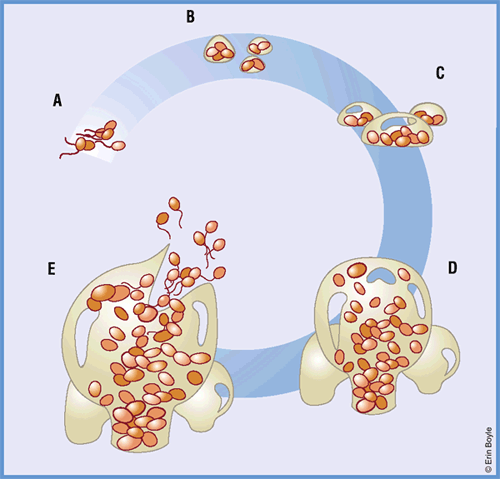
Quorum-sensing
Quorum-sensing bacteria produce molecules, termed autoinducers, that functions as chemical signal molecules. The concentration of these signals increase as a function of the number of cells in a colony. Using this chemical signaling, the bacteria can adapt to the current situation, and like a multicellular organism synchronize their behavior. The colony of bacteria forms biofilms, that are sessile microbial communities embedded in a self-produced extracellular polymeric matrix, with the advantages described above (16).
The strategy is that bacteria at a low level will express protein factors that promote attachment and colonization, whereas they at lager scale will repress these genes and instead express genes of toxins and proteases, that is factors that are required for dissemination (17).
In S. aureus the genes involved in quorum-sensing is encoded by the agr-locus (accessory gene regulator) system (16).
Two different promoters P2 and P3 drives the two operons of the arg-locus. The P2 operon codes for a RNAII transcript, while the P3 promoter drives transcription of RNAIII. RNAIII is an important part of the system as it regulates at least 15 genes coding for potential virulence factors (17).
The synthesis of RNAIII is regulated by quorum-sensing molecules. When autoinducers of the system reaches a threshold concentration RNAIII is synthesized. The described autoinducers of RNAIII is RAP (RNAIII activating protein) and the arg- encoded AIPs (autoinducing peptides) (17).
Quenrum-quenching using RIP
The ability to disrupt quorum sensing is known as quorum quenching. Quorum quenching has a great therapeutic potential, since interfering with the bacterial communication can prevent colonization of specific pathogen bacteria, that uses quorum sensing to coordinate virulence. (18)
RNAIII synthesis can be inhibited by different mechanisms. The most potent inhibition is seen by the RNAIII inhibiting peptide (RIP). This peptide has been described to be produced by coagulase negative staphylococcus, S. warnerii and S. xylosus. RIP has the sequence YSPXTNF, where X can be a cysteine, a tryptophan, or a modified amino acid.
Native RIP and a synthetic analogue YSPWTHF has been shown effective in inhibiting RNAIII synthesis in vitro and S.aureus infections in vivo. (18)
Fraklip
A natural corollary of the bacterial ability to communicate with each other and to sense their own numbers is their ability to aggregate into multicellular formations. Such formations offer protection and other advantages in the natural environment. Bacterial cells associated with each other in natural enviroments is called a biofilm. Biofilms trap nutrients for growth and microbial population and help prevent detachment af the cell from surfaces. Cell to cell communications is critical in development and maintenance of a biofilm. Attachment of a cell to surface is a signal for the expression of biofilm specific genes. These genes encode proteins that synthesize cell to cell signaling molecules and begin polysaccharide formation (10).
MRSA can potentially cause serious infections as blood stream infections, surgical site infections and pneumonia, and is espeicially troublesome because of it's resistance to common antibiotics.
Moreover S. aureus infections include pneumonia, endocarditis, osteomyelitis, food poisoning and more ([http://www.medicinenet.com/staph_infection/article.htm 5]).
At least four reasons undelie the formation af biofils. 1.) Biofilm are a type of defence. 2.) Biofilm formation allow cells to remain in a favorable niche. 3.) Biofilms form because they allow bacterial cells to live in close association with each other. 4.) Biofilm may be the typical way bacterial cells grow in nature (10)
MRSA is especially troublesome and the most common infectious agent among hospitalized patients. Patients with open wounds, invasive devices, and weakened immune systems are at great risk of infection ([http://www.cdc.gov/Features/MRSA/ 7]).
Hospital Infections
Hospital infections, also known as nosocomial infections, is very common, with a frequency of 7-10% of hospitalised patients (in Denmark) ([http://ssi.dk/sw671.asp 12]). One third of nosocomial infections are considered preventable ([http://en.wikipedia.org/wiki/Nosocomial_infection 13]).
The most common nosocomial infections are cystitis, pnemonia, postoperative wound infections and infections of intravascular catheter ([http://www.ouh.dk/wm139338 14]).
S. aureus is one of the most common causes of postoperative wound infections (15).
Contents |
 "
"
